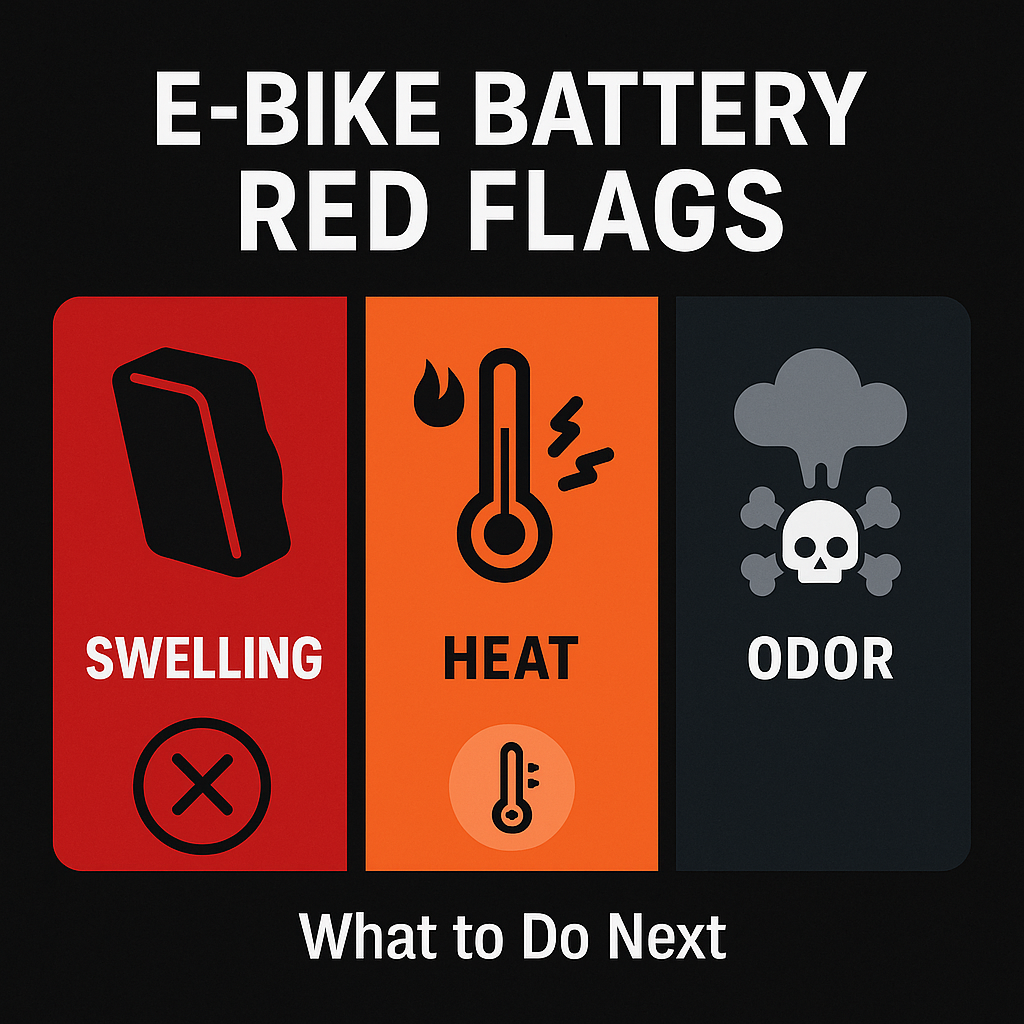Your e-bike battery is a reliable powerhouse, but like any piece of technology, it can show signs of distress. Ignoring these warning signals is one of the most dangerous mistakes an e-bike owner can make. In the rare event of a battery malfunction, knowing what to look for and, more importantly, what to do next can prevent a serious incident.
This guide will teach you the most critical "red flags" to watch for and provide a clear, step-by-step plan of action if you ever spot them. Think of this as your personal e-bike safety playbook.
The Critical Red Flags You Can’t Ignore
These are the immediate, unmistakable signs that your battery is compromised and should be treated with extreme caution.
1. Excessive Heat (Especially When Unplugged)
It's normal for your battery to feel a little warm after a long, strenuous ride or during a charging cycle. However, a battery that is excessively hot to the touch—uncomfortably hot, even—is a major warning sign.
- What it means: Uncontrolled heat is a primary cause of battery cell degradation and a precursor to thermal runaway, a dangerous, self-perpetuating chain reaction that can lead to fire. If your battery feels like a hot potato, it’s a problem.
2. Swelling or Bulging
This is arguably the most critical and visible red flag. A compromised lithium-ion battery can begin to swell, causing the casing to bulge or warp.
- What it means: Swelling is caused by the buildup of flammable gases inside the battery. This gas is a result of a breakdown in the battery’s internal chemistry, often triggered by overcharging, physical damage, or a manufacturing defect. A swollen battery is a ticking time bomb—the pressure inside can cause the casing to rupture, leading to an immediate fire.
3. Unusual Odors or Fumes
Your e-bike battery should be completely odorless. If you ever detect a strong, unusual, or acrid smell, it’s a sign of a serious problem.
- What it means: A pungent, sweet, or chemical odor—often described as similar to nail polish remover—is a sign that the battery’s internal electrolyte is venting gas. This is a direct indication of a chemical reaction gone wrong and a major fire risk.
4. Strange Sounds
A healthy e-bike battery is silent. A hissing, cracking, or popping sound coming from the battery is a sign of an internal short circuit.
- What it means: These sounds are a clear indication of a failure within the battery cells. A short circuit creates heat and can quickly lead to thermal runaway.
What to Do Next: Your Immediate Action Plan
If you ever notice any of these red flags, your first priority is to act quickly and safely. Do not panic. Follow these steps immediately.
Step 1: Disconnect and Isolate
- Unplug the charger immediately. If the battery is on the bike, turn it off. Do not use it.
- Move the battery to a safe, isolated area. If it is safe to do so, move the battery outdoors or to a fire-safe location like a garage with a concrete floor. Use thick gloves or tongs and avoid touching the battery directly. Place it in a metal bucket or container, away from anything flammable (papers, wood, textiles).
- Do NOT put the battery in your home trash, garage can, or recycling bin.
Step 2: Call for Help
- Call your local fire department (911). Inform them that you have a compromised lithium-ion battery. They can provide advice and, if necessary, assist in safely removing the battery from your property.
- Contact the manufacturer or retailer. Report the issue and ask for guidance on safe handling and return procedures. Do not attempt to repair the battery yourself, as doing so is incredibly dangerous.
Step 3: Dispose of it Properly
- Lithium-ion batteries cannot be thrown in the trash. They are considered hazardous waste.
- You must find a certified recycling facility that specializes in lithium-ion batteries. Look for resources like Call2Recycle or local hazardous waste facilities. Many retailers and bike shops also partner with recycling services and may accept your damaged battery for proper disposal.
Conclusion: Act Early, Stay Safe
An e-bike battery is a highly reliable component, and most owners will never experience these red flags. However, being prepared is the best defense. By knowing what to look for and having a clear action plan, you are empowering yourself to handle a rare but serious event with confidence and, most importantly, to keep your home and family safe.


Share:
E-Bike Battery Storage & Transport: 40–60% Rule, Fire Safety & Travel Tips
Ride Farther on One Charge: 10 Proven Range Boosters